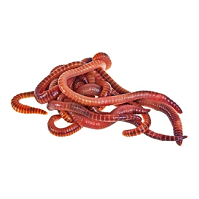Energetic red wigglers: Start vermiculture today
Wiki Article
Whatever You Need to Learn About Red Wigglers for Composting
Red wigglers, or Eisenia fetida, play a pivotal role in the realm of composting, changing natural waste into useful soil amendments. The procedure of establishing up a worm bin and maintaining it can pose obstacles.What Are Red Wigglers?

(buy red wiggler worms) Belonging To The United States and copyright, red wigglers are surface-dwelling organisms that prefer wet, cozy habitats abundant in breaking down natural matter. Their diet plan consists mainly of decaying plant product, food scraps, and various other natural particles, which they consume and damage down successfully. As they digest this material, they generate nutrient-rich spreadings that improve soil fertility.
Red wigglers are hermaphroditic, possessing both male and women reproductive organs, and can duplicate swiftly under ideal conditions. This capability makes them a perfect selection for composting systems, as their population can boost rapidly. Their durability and flexibility to different settings better solidify their relevance in sustainable waste administration practices. Generally, red wigglers are vital factors to the procedure of recycling natural waste right into useful compost.
Benefits of Utilizing Red Wigglers
Making use of red wigglers in composting systems offers various benefits that boost both the efficiency of waste administration and the high quality of the resulting garden compost. These worms, medically referred to as Eisenia fetida, are specifically effective at breaking down organic matter, turning kitchen area scraps and lawn waste into nutrient-rich garden compost at an accelerated price.Among the main advantages of utilizing red wigglers is their ability to consume big quantities of natural product, usually refining their weight in food waste daily. This high consumption price leads to quicker decomposition and lowers the quantity of waste sent out to garbage dumps. The castings created by red wigglers are rich in important nutrients, advantageous microbes, and enzymes, making them a superb plant food for gardens and plants.
In addition, red wigglers flourish in a variety of environments, making them versatile for both interior and outside composting systems - red wigglers. Their presence in a garden compost container assists to freshen the material, protecting against smells and advertising a healthy and balanced composting process. On the whole, employing red wigglers not just adds to effective waste management yet likewise supports lasting gardening methods via the manufacturing of top notch compost
(Lake Hickory Bait)
Establishing Your Worm Container
To successfully establish a worm bin, it is necessary to choose an appropriate container that fulfills the requirements buy red wiggler worms of red wigglers while supplying a helpful setting for composting. An ideal bin can be made from plastic, wood, or steel, with an ability of at the very least 1 square foot for every extra pound of worms.Make sure the container has ample water drainage openings to prevent excess dampness, as red wigglers prosper in a wet, yet not water logged, setting. red wigglers. The bin ought to additionally be ventilated to offer adequate airflow, stopping anaerobic problems that can damage the worms
A perfect area for the worm container is a great, dark location, devoid of direct sunlight and extreme temperature levels, as red wigglers choose a temperature series of 55 to 77 levels Fahrenheit.
Before presenting the worms, prepare bed linens products such as shredded newspaper, cardboard, or coconut coir, which will give both habitat and food. Dampen the bedding gently to create a welcoming setting for the worms. Last but not least, take into consideration positioning a cover on the bin to maintain humidity and reduce parasites, while guaranteeing it can be easily removed for upkeep.
Feeding and Treatment Guidelines
Feeding red wigglers is an essential aspect of keeping a healthy and balanced composting system. These worms thrive on a varied diet regimen, primarily composed of organic materials such as fruit and vegetable scraps, coffee premises, and crushed eggshells. It is important to avoid feeding them meat, dairy, and oily foods, as these can produce unpleasant odors and draw in insects.When introducing food to your worm container, cut or shred products right into smaller sized pieces to promote quicker decomposition. Begin with small amounts to evaluate the worms' consumption price, gradually boosting the quantity as they adapt. It is advisable to alternating feeding areas within the container to urge detailed mixing and oygenation of the garden compost.

Troubleshooting Common Issues
Keeping a prospering worm composting system can often present challenges that require attention and troubleshooting. Usual issues consist of an undesirable odor, which often indicates overfeeding or the visibility of anaerobic problems. To remedy this, minimize the amount of food added and make certain correct aeration by mixing the bed linens material.Another frequent trouble is the getaway of worms from the bin. This can occur due to excessive wetness or unsuitable ecological problems. Frequently inspect the dampness levels, going for a moist however not soaked consistency, and keep ideal temperatures in between 60-80 ° F(15-27 ° C )to produce a comfy environment for your red wigglers.
Pests, such as fruit flies, can additionally invade worm containers. red wigglers. To fight this, cover food scraps with a layer of bed linens or shredded paper to hinder flies from laying eggs. In addition, make sure that any food included is fresh and without mold and mildew, which can attract undesirable pests
Finally, if your worms appear non-active, look for anxiety variables such as temperature level changes or poor moisture. Attending to these common problems will certainly help preserve a healthy and balanced and productive worm composting system.
Verdict
In summary, red wigglers, or Eisenia fetida, play a vital role in sustainable waste administration with vermicomposting. Appropriate configuration and upkeep of a worm bin, along with adherence to feeding standards, make certain a thriving community that reduces landfill contributions.Report this wiki page